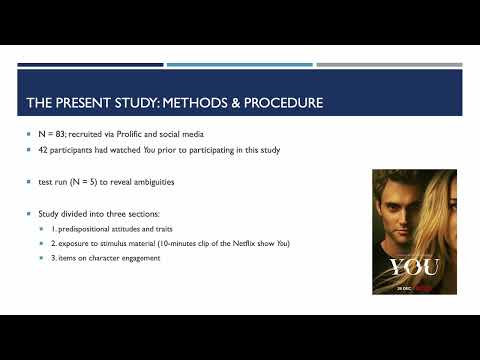 Speaker: Lena Weinrank @LenaW
Speaker: Lena Weinrank @LenaW
 Affiliation: RWTH Aachen
Affiliation: RWTH Aachen
Title: Rooting for the Bad Guy in Netflix Shows. Empirically Investigating the Interplay between Identification, Moral Disengagement, Dark Character Preferences and SPS.
Abstract (long version below): In this study, I delved into the relations between individual differences across viewers (propensity to morally disengage, Machiavellianism, dark character preferences, and imaginative resistance) and identification with morally ambiguous characters through mechanisms of actual moral disengagement, while also pointing out their importance for character liking. I conducted a quantitative study (N = 83), in which I found that there are relations between individual differences, identification, and actual moral disengagement, but also within the individual differences (e.g. Machiavellianism and dark character preferences were positively correlated). Further, I investigated the activation of storyworld possible selves and found that present and feared SPSs were activated most frequently.

 Long abstract
Long abstract
To this date, a great number of studies has focused on the phenomenon of morally ambiguous characters (e.g. Janicke and Raney Modeling the Antihero Enjoyment; Sanders and Tsay-Vogel; Krakowiak and Tsay; Black et al.). With this thesis, I want to contribute to the existing line of research by providing an empirical investigation in which I try to outline associations between individual differences across viewers (propensity to morally disengage, Machiavellianism, dark character preferences, and imaginative resistance) and identification with morally ambiguous characters through mechanisms of actual moral disengagement, while also pointing out their importance for character liking.
To go beyond the objects of investigation of previous studies, I further introduce the activation of Storyworld Possible Selves (SPS) to this field of research. SPSs can be defined as blends between the reader, in this case the viewer, and the character (cf. Loi et al. 44). I distributed an online survey via SoSciSurvey (N = 83) in which viewers were confronted with scenes from Netflix’s famous show You. In this study, I collected data on their personality traits, as well as on their engagement with the morally ambiguous protagonist Joe Goldberg. I found that individual differences of Machiavellianism, dark character preferences, and the propensity to morally disengage are highly correlated and that dark character preferences are
strongly associated with both identification and actual moral disengagement. Further, in line
with a previous study (cf. Janicke and Raney Modeling the Antihero Enjoyment), character
liking was found to be predicted by actual moral disengagement and identification, whereby
the latter mediated the relation between actual moral disengagement and character liking.
The second focus was on SPSs. In regards to their activation, I found that present self SPSs and feared self SPSs were activated most frequently which partially contradicts general trends as proposed by Loi et al. (cf. 58). In sum, the study suggest that liking identification and actual moral disengagement are in fact predicted by individual differences and that they facilitate character liking. It also supports the assumption that the activation of SPSs depends on genres and the emergent situations that characters find themselves in (cf. ibid.).

